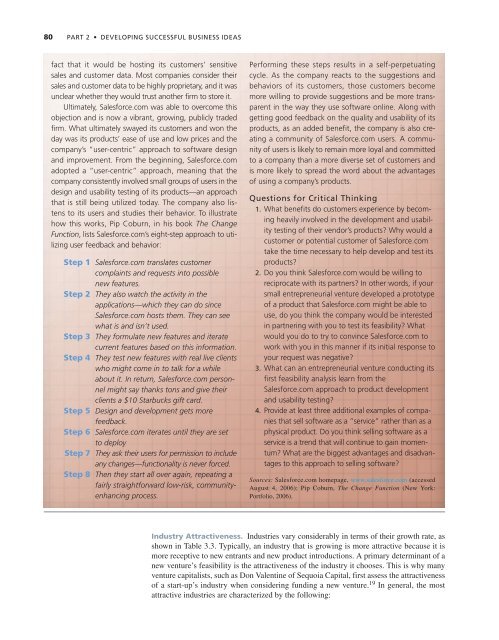feasibility analysis feasibility analysis
feasibility analysis feasibility analysis
feasibility analysis feasibility analysis
Create successful ePaper yourself
Turn your PDF publications into a flip-book with our unique Google optimized e-Paper software.
80 PART 2 • DEVELOPING SUCCESSFUL BUSINESS IDEAS<br />
fact that it would be hosting its customers’ sensitive<br />
sales and customer data. Most companies consider their<br />
sales and customer data to be highly proprietary, and it was<br />
unclear whether they would trust another firm to store it.<br />
Ultimately, Salesforce.com was able to overcome this<br />
objection and is now a vibrant, growing, publicly traded<br />
firm. What ultimately swayed its customers and won the<br />
day was its products’ ease of use and low prices and the<br />
company’s “user-centric” approach to software design<br />
and improvement. From the beginning, Salesforce.com<br />
adopted a “user-centric” approach, meaning that the<br />
company consistently involved small groups of users in the<br />
design and usability testing of its products—an approach<br />
that is still being utilized today. The company also listens<br />
to its users and studies their behavior. To illustrate<br />
how this works, Pip Coburn, in his book The Change<br />
Function, lists Salesforce.com’s eight-step approach to utilizing<br />
user feedback and behavior:<br />
Step 1 Salesforce.com translates customer<br />
complaints and requests into possible<br />
new features.<br />
Step 2 They also watch the activity in the<br />
applications—which they can do since<br />
Salesforce.com hosts them. They can see<br />
what is and isn’t used.<br />
Step 3 They formulate new features and iterate<br />
current features based on this information.<br />
Step 4 They test new features with real live clients<br />
who might come in to talk for a while<br />
about it. In return, Salesforce.com personnel<br />
might say thanks tons and give their<br />
clients a $10 Starbucks gift card.<br />
Step 5 Design and development gets more<br />
feedback.<br />
Step 6 Salesforce.com iterates until they are set<br />
to deploy<br />
Step 7 They ask their users for permission to include<br />
any changes—functionality is never forced.<br />
Step 8 Then they start all over again, repeating a<br />
fairly straightforward low-risk, communityenhancing<br />
process.<br />
Performing these steps results in a self-perpetuating<br />
cycle. As the company reacts to the suggestions and<br />
behaviors of its customers, those customers become<br />
more willing to provide suggestions and be more transparent<br />
in the way they use software online. Along with<br />
getting good feedback on the quality and usability of its<br />
products, as an added benefit, the company is also creating<br />
a community of Salesforce.com users. A community<br />
of users is likely to remain more loyal and committed<br />
to a company than a more diverse set of customers and<br />
is more likely to spread the word about the advantages<br />
of using a company’s products.<br />
Questions for Critical Thinking<br />
1. What benefits do customers experience by becoming<br />
heavily involved in the development and usability<br />
testing of their vendor’s products? Why would a<br />
customer or potential customer of Salesforce.com<br />
take the time necessary to help develop and test its<br />
products?<br />
2. Do you think Salesforce.com would be willing to<br />
reciprocate with its partners? In other words, if your<br />
small entrepreneurial venture developed a prototype<br />
of a product that Salesforce.com might be able to<br />
use, do you think the company would be interested<br />
in partnering with you to test its <strong>feasibility</strong>? What<br />
would you do to try to convince Salesforce.com to<br />
work with you in this manner if its initial response to<br />
your request was negative?<br />
3. What can an entrepreneurial venture conducting its<br />
first <strong>feasibility</strong> <strong>analysis</strong> learn from the<br />
Salesforce.com approach to product development<br />
and usability testing?<br />
4. Provide at least three additional examples of companies<br />
that sell software as a “service” rather than as a<br />
physical product. Do you think selling software as a<br />
service is a trend that will continue to gain momentum?<br />
What are the biggest advantages and disadvantages<br />
to this approach to selling software?<br />
Sources: Salesforce.com homepage, www.salesforce.com (accessed<br />
August 4, 2006); Pip Coburn, The Change Function (New York:<br />
Portfolio, 2006).<br />
Industry Attractiveness. Industries vary considerably in terms of their growth rate, as<br />
shown in Table 3.3. Typically, an industry that is growing is more attractive because it is<br />
more receptive to new entrants and new product introductions. A primary determinant of a<br />
new venture’s <strong>feasibility</strong> is the attractiveness of the industry it chooses. This is why many<br />
venture capitalists, such as Don Valentine of Sequoia Capital, first assess the attractiveness<br />
of a start-up’s industry when considering funding a new venture. 19 In general, the most<br />
attractive industries are characterized by the following:

















